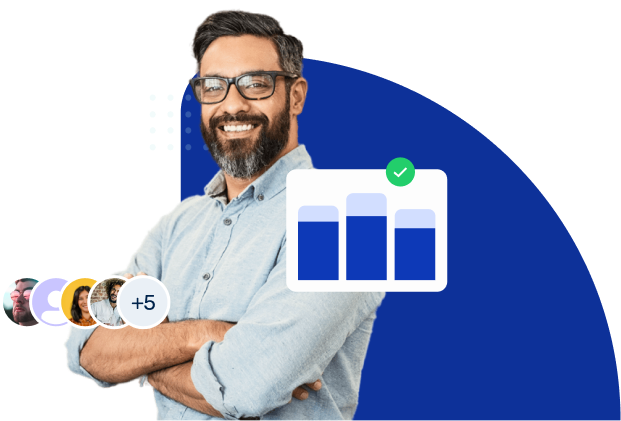As a leading SaaS application development company in India, we offer comprehensive solutions from consulting and architecture to UI/UX design, product development, testing, and ongoing support.
Transform your SaaS idea into reality with our consultation services. We help plan development roadmaps, estimate costs, and provide project guidance for success.
Craft tailored software architecture using cutting-edge tools and technologies to meet your business requirements effectively and efficiently.
Deliver exceptional user experiences with our expertly designed user flows, wireframes, and intuitive interfaces that engage and delight your users.
Accelerate time-to-market with our iterative product development approach, leveraging advanced technologies for robust and scalable solutions.
Ensure the highest quality standards for your SaaS application with our rigorous testing at every development stage, delivering reliable and flawless products.
Integrate your SaaS product seamlessly with third-party applications and services through custom APIs, enhancing its functionality and interoperability.
Our SaaS application development company ensure the security and compliance of your SaaS app with robust data protection measures and adherence to industry regulations.
Extend the reach of your SaaS product with native or cross-platform mobile apps, providing users with access anytime, anywhere, on any device.
Start your journey towards digital transformation with our SaaS application development company, delivering tailored solutions to meet your unique business needs.

Partner with PixelCrayons for unparalleled expertise in SaaS development, where innovation, quality, and efficiency converge seamlessly.
Our team comprises India’s top 1% software talent, ensuring the delivery of secure, resilient, and cost-effective SaaS solutions tailored to your business needs.
We build robust and scalable SaaS platforms tailored to your unique business needs.
Regardless of your business size or sector, our software engineering expertise will help grow your operations, automate process, and increase revenue.






Tailoring the Approach to Your Needs

Embrace the culture of collaboration and continuous improvement with DevOps. Our approach integrates development and operations for faster delivery, higher software quality, and more reliable releases, enhancing responsiveness to market changes.

Adopt a flexible and efficient development approach with Agile. Our Agile methodology promotes adaptive planning, evolutionary development, early delivery, and continual improvement, encouraging rapid and flexible response to change.

Implement Scrum for a more structured yet flexible development process. This iterative approach divides development into sprints, focusing on delivering specific features within a set timeframe, fostering teamwork, accountability, and iterative progress.

Choose Waterfall for its sequential, linear approach to software development. Ideal for projects with well-defined requirements and scope, our Waterfall methodology emphasizes meticulous planning, documentation, and stage-wise progression for a structured and disciplined delivery.
PixelCrayons, a leading SaaS product development company, uses agile methodologies for timely delivery. Partner with us for dedicated teams, staff augmentation, or mobile app outsourcing solutions.
We are a dedicated and reliable partner, committed to delivering your SaaS project on time and within budget.

With expertise in C, C++, and Python, our expert team engineer stable systems for security, storage, and file management. We specialize in embedded software for industrial and home automation.
Leveraging .NET, Java, PHP, Python, and Ruby, we create robust solutions for various business needs, driving efficiency across industries and consumer engagement.
Excelling in automation, HMI development, PLC programming, and third-party integrations, we streamline operations with customized software solutions for plant automation and process control.
We specialize in engineering custom software that's both stable and secure, using a variety of tech tools.
Defining goals and planning for a successful software project.
Creating intuitive design and robust architecture for user engagement.
Building and rigorously testing for reliable, secure software performance.
Launching software smoothly in live environments with minimal downtime.
Delivering software with ongoing support and future enhancements available.
Our software product development company in India works on the latest technologies to get the best solutions for your specific industry needs. Our SaaS development firm also keeps its programmers updated with modern technological trends.
With us, you can choose from multiple hiring models that best suit your needs.

Hire an autonomous expert team that, consists of Software Engineers, Quality Analysts, Project Managers and other professionals to deliver efficient and timely technology solutions. Job roles and responsibilities of our experts are discreetly defined for each project, and management is jointly handled by a Scrum Manager and the client’s product owner.

Our team augmentation model allows you to select the right set of talent and experience helping you fill the talent gap in your team. The augmented team works as part of your local or distributed team, attends daily meetings, and directly reports to your managers. This hiring model is suitable for businesses and projects of all sizes.

It is obtained when the project specifications, scope, deliverables, and acceptance criteria are clearly defined, enabling us to evaluate and frame a fixed quote for the project. It best suits the small-mid scale projects having well-documented specifications.
Time & Material Model:It best suits projects with a dynamic scope or complicated business requirements, hindering accurate cost estimation. You pay for the services according to the time spent on the project and get an opportunity to realise the optimum benefits.
Here is our complete guide on SaaS development that you can consider for your next big project. This will help you learn about the process, get detailed information, and choose the right SaaS app development company to meet your business needs.
![]()
Software as a Service (SaaS) product development offers the following benefits for businesses:
SaaS products are built to scale effortlessly to meet corporate needs. They can handle rising user demand, accommodate expanding data quantities, and modify for shifting corporate needs. Due to this flexibility, firms can readily increase their operations without incurring major infrastructure costs or causing substantial downtime.
SaaS eliminates the need for businesses to invest in hardware, software licenses, and ongoing maintenance. Instead, they pay a subscription charge dependent on consumption, lowering up-front expenditures. SaaS providers also take care of infrastructure upkeep, security patches, and software updates, easing pressure on organizations’ IT departments and lowering associated expenses.
3. Accessibility & Collaboration
Any device with an internet connection can access SaaS items online. This accessibility promotes real-time data exchange and updates, remote work, and improved cooperation across teams and locations. Employee collaboration is seamless, increasing output and effectiveness.
4. Continuous Updates & Innovation
SaaS providers regularly update the software and add new features. With no need for manual updates, this guarantees that organizations always have access to the newest functionality, advancements, and security upgrades.
5. Easy Integration & Customization
SaaS products are made to easily integrate with other software systems and business-oriented apps. As a result, workflows are streamlined, seamless data sharing is possible, and overall productivity is increased.
6. Data Security & Reliability
SaaS companies prioritize data security and use effective security measures to safeguard sensitive corporate data. They guarantee compliance with industry rules, disaster recovery strategies, and data backups.
7. Improved Time to Market
SaaS enables enterprises to swiftly deploy software products without requiring infrastructure setup or protracted development cycles. This enables them to promote their goods or services more quickly, establish a competitive advantage, and take advantage of new opportunities.
![]()
The SaaS (Software as a Service) product development lifecycle typically involves several steps to ensure the successful development, launch, and ongoing maintenance of a SaaS application. Here are the key steps in the SaaS product development lifecycle:
1. Idea & Conceptualization
The initial phase is to pinpoint a market need or issue that a SaaS solution can address. Defining the product’s aims and objectives as well as doing market research, are all part of this process.
2. Gathering Requirements
After the product concept is defined, gathering requirements is the next phase. Understanding the exact features, functionalities, and user expectations for the SaaS product is necessary to do this. To achieve thorough requirement collecting, it is crucial to include stakeholders like customers and internal teams.
3. Design & Architecture
The SaaS product’s design and architecture are made based on the requirements that have been gathered. The user interface, system architecture, data models, and technological stack definition are all included in this.
4. Development
The SaaS product is actually developed during this stage. Coding, testing, and integrating diverse components are all required. Iterative development and frequent feedback loops are prevalent practices in agile development approaches, guaranteeing that the final product satisfies the specifications.
5. Testing
After the initial development is finished, thorough testing is done to find and address any defects or problems. This covers user acceptance testing (UAT), performance testing, security testing, and functional testing.
6. Deployment & Launch
The SaaS solution is launched into a production environment following successful testing. It involves setting up the appropriate infrastructure, databases, and servers. After that, saas marketing and sales initiatives may be started to draw buyers to the product.
7. Customer Onboarding & Support
After the product goes online, protocols are built for customer onboarding to assist new users in utilizing the SaaS platform development. This can entail offering guides, instruction, and support channels. For a SaaS solution to be successful, ongoing maintenance and customer support are essential.
8. Continuous Improvement & Updates
The SaaS product should be updated often depending on customer input, industry trends, and changing demands. Updates, feature upgrades, and bug fixes are often delivered to address user input and ensure the product remains valuable and competitive.
9. Security & Compliance
Security and compliance should be continuously prioritized throughout the SaaS product development lifecycle. Regular security audits, vulnerability analyses, and compliance checks are carried out to protect user data and guarantee compliance with pertinent laws and standards.
To know more about how SaaS application development services can help you, read our blog post.
![]()
Outsourcing SaaS (Software as a Service) product development can offer several advantages for startups and enterprises. Here are some key benefits:
Advantages for Startups
1. Cost Savings
For startups, hiring an in-house development team may be more expensive than outsourcing SaaS product development. The requirement for hiring and training workers, establishing infrastructure, and controlling overhead costs are all eliminated by outsourcing. To know more read our blog.
2. Time management
To get their products to market as soon as possible, startups frequently face strict timelines. Startups can use the knowledge and experience of outside teams by outsourcing development so they can devote all of their time to the project.
3. Access to Knowledge
By outsourcing, entrepreneurs can access a larger talent pool and more specialized expertise. They have the option of selecting development partners who have the relevant industry knowledge and SaaS product development experience.
4. Scalability
As startups expand, their SaaS product may need more capacity, features, or functionality. Startups can increase their development resources rapidly and flexibly by outsourcing.
Advantages for Enterprises
1. Focus on Core Competencies
Businesses sometimes have different departments and complex business activities. By giving the creation of SaaS products to outside professionals, they can concentrate on their core capabilities.
2. Faster Time-to-Market
Outsourcing development might help businesses who want to improve current SaaS products or launch new ones. External teams can work on the project solely, which will hasten development and shorten time-to-market.
3. Access to Specialised Skills
The creation of SaaS products necessitates various abilities, including knowledge in UX/UI design, front-end development, back-end development, quality assurance, and security. Businesses can access specialized expertise through outsourcing that may not be present internally.
4. Cost Reduction
Outsourcing SaaS product development can save costs and boost business return on investment. By outsourcing to areas with cheaper labor prices, they can also profit from cost arbitrage and save overall development costs.
![]()
Successful SaaS (Software as a Service) product development requires incorporating essential features that cater to the needs and expectations of users. Here are some of the SaaS product features explained below:
Successful SaaS (Software as a Service) product development requires incorporating essential features that cater to the needs and expectations of users. Here are some of the SaaS product features explained below:
1. User Authentication & Security
To guarantee secure access to the SaaS product, strong user authentication procedures are necessary. This includes options like secure session handling, two-factor authentication, and password management.
2. User Experience (UX) & User Interface (UI)
Any SaaS product’s success depends on having an intuitive user interface and a smooth user experience. The user interface must be responsive, aesthetically pleasing, and intuitive on all devices.
3. Flexible & Adjustable Configurations
Giving users the ability to alter the SaaS product to suit their own requirements. Options for customization may include workflows, settings, preferences, and branding. Users may customise the product thanks to flexible setup, increasing their pleasure and boosting adoption rates.
4. Collaboration & Communication for Tools
SaaS products frequently act as platforms for collaboration. Collaboration between users is improved by including communication-friendly capabilities including real-time messaging, chat, video conferencing, and document sharing.
5. Analytics & Reporting
Giving users access to powerful analytics and reporting tools empowers them to analyse their data and come to wise judgements. Users may track performance, spot trends, and monitor critical data using dashboards, visualisations, and custom reports.
6. Integration & API Support
For SaaS products, integrations with other software platforms and services are essential. Users can integrate the product with their current tools and workflows by taking advantage of integration options and application programming interfaces (APIs) offered by the vendor.
7. Support & Documentation
Ensuring users have access to thorough support materials is essential. By providing timely customer service methods, such email or live chat, you can quickly respond to consumer questions and problems.
8. Regular Updates & Maintenance
In order to increase functionality, fix issues, and improve security, SaaS systems need constant updates and maintenance. Users are guaranteed a current and dependable product experience with the regular release of new features, bug fixes, and performance improvements.
9. Pricing & Subscription Management
SaaS applications use the subscription business model that follows well-designed pricing and subscription management system. This contains attributes like various pricing tiers, adaptable billing cycles, payment channels, and interfaces for subscription administration.
Many businesses are opting for SaaS application development services in India to utilize cost-effective solutions and access a pool of skilled professionals in the industry.
![]()
Choosing the right outsourcing SaaS development company is crucial for the success of your project. Here are some SaaS development best practices to consider before making an important decision:
1. Expertise & Experience
Look for a SaaS development company in India with great expertise in SaaS. Check their portfolio and see if they have experience in building similar products. It ensures they understand the specific challenges and requirements of the SaaS industry.
2. Technical Skills & Technologies
Assess the technical skills and technologies in which the SaaS product development services provider specializes. Ensure they have proficiency in the programming languages, frameworks, and tools necessary for your SaaS product. It ensures they can effectively develop and maintain your product using the latest technologies.
3. Project Management Approach
Evaluate the company’s project management approach. Effective communication, regular updates, and a collaborative work style are crucial. Look for companies that follow agile methodologies, offering flexibility, transparency, and shorter development cycles.
4. Client References & Reviews
Request client references and read reviews about the outsourcing company. This provides insights into their reputation, reliability, and the satisfaction level of their previous clients. Contacting references directly can give you firsthand information about their experience working with the company.
5. Communication & Language Skills
Effective communication is vital for successful collaboration. Ensure the outsourcing company has strong communication skills and can understand your requirements clearly. Language proficiency is also important, so consider companies that have a good command of the language you communicate in.
6. Security & Data Protection
SaaS products deal with sensitive user data, so security is paramount. Assess the outsourcing company’s security measures, data protection practices, and compliance with relevant regulations. They should have strict security protocols in place to safeguard user information and prevent data breaches.
7. Cost & Budget
While cost is a factor, it should not be the sole deciding factor. Evaluate the pricing structure of the outsourcing company and ensure it aligns with your budget. Consider their value regarding expertise, quality, and long-term partnership rather than simply choosing the cheapest option.
8. Cultural Fit & Time Zone Compatibility
Assess the cultural fit between your organization and the outsourcing company. A shared understanding of work culture and values can facilitate a smoother collaboration. Additionally, consider the time zone difference to ensure sufficient overlap for communication and collaboration.
9. Long-term Partnership Potential
SaaS product development is an ongoing process. Consider the outsourcing SaaS development company’s potential for a long-term partnership. Evaluate their commitment, stability, and willingness to support your product beyond the initial development phase.
![]()
Agile is a flexible approach to software development that emphasizes collaboration, continuous improvement, and adaptive planning. It breaks projects into smaller, manageable tasks called “sprints,” allowing teams to quickly respond to changes and deliver functional software.
Here is the saas product roadmap in agile methodology:
Gain industry insights and learn from our proven track record with our latest blogs and case studies.
With Software as a Service (SaaS), users can subscribe to and access programs hosted on remote servers more efficiently with…
Learn MoreStruggling to keep up with the digital landscape in the healthcare industry? It can be difficult to navigate the complexities…
Learn MoreUnsure about choosing the new SaaS product development for your business? Well, with so many factors to consider - from…
Learn MoreAre you thinking about creating a SaaS product? Maybe you're already in the process of making one. No matter where…
Learn MoreHere are some of the frequently asked questions about SaaS development services our clients often ask. Do you have any queries related to SaaS application development? Feel free to contact us.
A SaaS application has uses across many different business industries. SaaS solutions can be used in various industries, including project management, healthcare, finance, education, eCommerce, and human resources. Any industry that needs software functionality offered online can profit from SaaS’s adaptability and scalability.
Yes, we provide post-release support for SaaS products. Our support services include bug fixes, performance optimization, security updates, feature enhancements, and technical assistance. We understand the importance of maintaining and evolving the product to meet user needs and industry trends. Our support team is dedicated to ensuring the long-term success and smooth operation of the SaaS application.
In a SaaS model, the software application is hosted on the provider’s servers and delivered to users over the internet. Instead of purchasing and installing the software locally, users access the application through a web browser or dedicated client. Users typically pay a subscription fee for the services provided by SaaS product development company, which covers software usage, maintenance, updates, and support. The provider manages the infrastructure, security, and ongoing development, while users enjoy the convenience and scalability of accessing the software from anywhere with an internet connection.
The cost of building a SaaS app depends on various factors, including the complexity of the application, the number of features, the technology stack, the level of customization, and the development team’s rates. Providing an exact cost without a detailed understanding of the project requirements is challenging. However, building a SaaS app typically involves a significant investment that covers initial development, ongoing maintenance, support, and future updates. After discussing your specific needs and goals, our SaaS product development company can provide a more accurate estimate.
Custom building a SaaS platform offers several advantages. It allows you to tailor the software to meet your business requirements, ensuring a more precise fit and superior functionality. Customization enables seamless integration with your existing systems, workflows, and branding. It gives you full control over the platform’s features, user experience, and scalability, giving you a competitive edge in the market.

Boost your business operations and stay ahead of the competition with our innovative SaaS development services.
Let us show you how our digital services can drive your success.